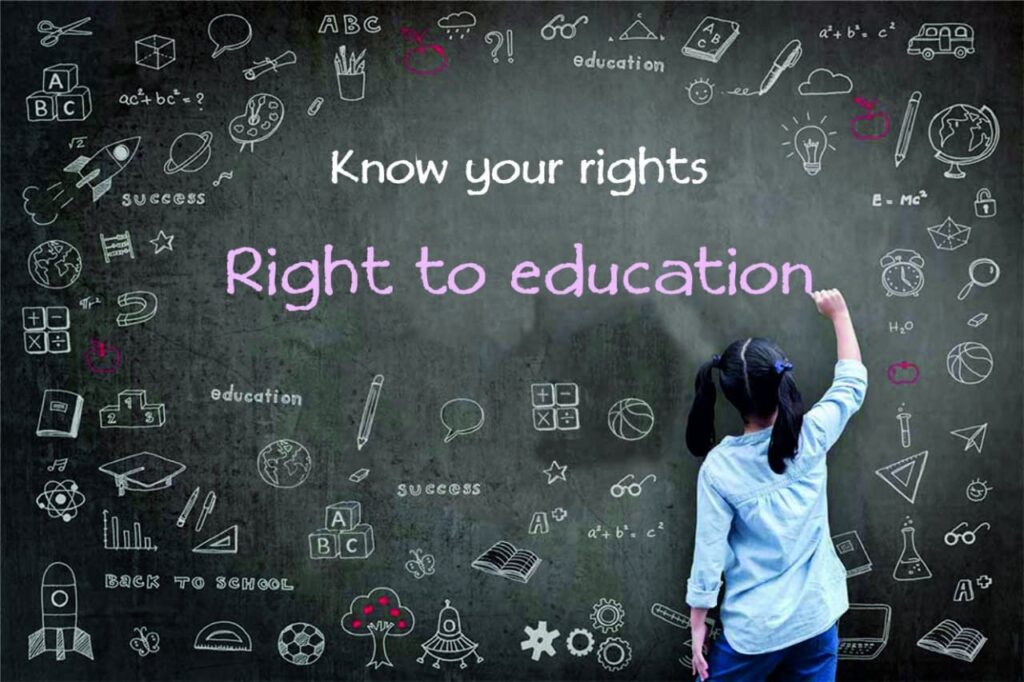
Author- Surbhi Saumya, Law student, CCS University, Meerut
Introduction:
RTE Act,2009 or Right to Education Act,2009 was passed to increase the education rate in India that enables children of age six to fourteen with free and compulsory education. It was passed by the Rajya Sabha on 20th July 2009, and Lok Sabha on 4th August 2009. It came into force on 1st April 2010. Its applicability includes the whole of India including Jammu and Kashmir (as stated under Section-1 of this Act). The Act has seven chapters and thirty-eight sections, a Preamble, and a Schedule.
Constitution and Right to Education:
The 86th Constitutional Amendment brought changes concerning education:
- Adding Article-21-A
The insertion of Article-21-A (through Unni Krishnan, J.P. &Ors vs. State of Andra Pradesh &Ors. 1993 AIR 2178, 1993 SCR (1) 594) makes the government liable for the free and compulsory education of children between 6-14 years of age regardless of their background, caste, gender, religion, or any other basis of discrimination.
- Adding Article-51-A(k)
The insertion of Article-51-A(k) makes the parents or guardians liable for the education of their children or ward between 6-14 years of age.
- Substituting Article-45
According to the new addition in Article-45, the State has to ensure the free and compulsory education of all children between 6-14 years of age regardless of any discrimination. Previously, the mention of discrimination wasn’t there in this.
Features of the Act
- Section-2 states the definitions for appropriate government, capitation fee, parent, school, child, National Commission for Protection of Child Rights, guardian, etc from Section-2(a) to Section 2(q).
- Section-3(1) of this Act, states that free and compulsory education till the elementary level is a part of the Fundamental Rights.
- Section-3(2) of this Act, provides free study materials including textbooks and writing materials. The same section also provides no school fees of any kind till the elementary level.
- Section-3 (3) of this Act, provides children with disabilities with the same facilities of getting free education with free study materials as well as no fee like a normal elementary student.
- Section-4 of this Act provides children with no previous education or those who had to leave their education in the middle to continue their education or begin their education with the standard that suits their age. Also, this Act continues to provide such children with further free education as well even after the age of fourteen years till their elementary school education.
- Section-12 of this Act provides children from economically weaker sections to have 25% reservation at aided schools.
Important Cases Under this Act:
- Mohini Jain v. State of Karnataka, 1992- SC Two Judges Bench
- Unni Krishnan, JP v. State of Andra Pradesh, 1993- SC Five Judges Bench
- TMA Pai Foundation v. State of Karnataka, 2003- SC 11 Judges Bench (with 6:5 majority)
- Action Committee Unaided Recognised Schools v. Justice for All, 2021- SC Two Judge Bench
Practical Applicability of The Act
The practical applicability of the Act can be determined through the rate of enrolments before and after the exhibition of this Act. The following table shows the increase in enrolments after the collection of the RTE Act, 2009.
Table: Percentage increase in enrolment in the upper primary levels
| Year | No. of students enrolled in class VI-VIII (upper primary) | Year-on-year increase (in %) |
| 2007-08 | 50,911,110 | NA |
| 2009-10 | 54,467,415 | 6.5 |
| 2011-12 | 61,955,154 | 12 |
| 2013-14 | 66,471,219 | 6.8 |
| 2015-16 | 67,593,727 | 1.7 |
Although the overall rate has increased, the state-wise enrolment after the passing of this Act has different data.
In some states like Bihar, U.P., and Rajasthan there has been an increase in the enrolment rate with varying percentages whereas, on the other hand, states like Madhya Pradesh, Assam, and West Bengal faced varying decreases in the enrolment rate.
Possible Reasons for the increase in enrolment rate
There are multiple possible reasons for the increase in enrolment rate after the enforcement of this Act. Two of them are listed below.
1. Reservation
The 25% criteria established for the EWS or economically weaker sections has motivated a lot of parents to educate their children. Everyone wants to live a better life someday and this criteria makes the parents feel like their children can make their dreams come true.
2. No discrimination
In a world where people have to face harassment and live through the horrors of discrimination, equity is what people seek. To feel like an equal is unfortunately only a dream of many. With the concept of no discrimination provided by the Act, parents feel safe in enrolling their children in school, and this creates a safe space for the children as well. The parents who never got the chance to fight discrimination also feel safe in making their children a secure and zero discriminating space.
Possible Reasons for the decrease in enrolment rate:
- Poverty
The reason behind this decrease could mainly be poverty. Parents who cannot afford the money to provide good food and safe shelter for themselves don’t have the idea of educating their children for a better future, to them, being able to work and earn a living is enough. Some sources have claimed that half a million of India’s population includes beggars. And to these beggars, even the knowledge of the law of the RTE Act would be an illusion. To them, a day’s food would be enough.
- Unawareness of RTE
Despite the efforts of spreading knowledge on the importance of education and the implementation of the Right to Education as a separate Act, some people are still unaware of it.
The media that covers the information on the enforcement of such Acts is available to people who have television, smartphones, laptops, or such electronics to be aware of the law, but those people, most of them, have already enrolled their children in schools.
It is the poor that need awareness on such topics.
And the awareness shouldn’t be limited to them being explained what the Right to Education is, it should also be about how this can bring a change in their family conditions and improvise their finances.
- Discrimination in poverty
Although the Act ensures that the children are treated equally, it does not guarantee the safety from harassment and bullying that children from economically weaker sections have to face because of their family backgrounds. Sadly, this makes them drop out of school at times too or discourages them to join the school.
4. Money over education
“You don’t need the education to earn money.” This line could be heard by many people and is somewhat true as well. But the importance of literacy is known only to the ones who have gained knowledge. Many children are found on stalls selling random products or vegetables, supporting their families, and they choose to do so instead of getting an education because it is easy money. They don’t see the bigger picture nor they do look for it. To them, idealism is a lifestyle earned through money.
Conclusion:
The theoretical part of RTE and the practical aspect of this Act are entirely different. Although, once enforceable, the law has to be followed but sadly, in our country, it is not the passing of an Act that brings change to everyone, it is the awareness that our country is still behind. It is only the people that can bring the change and although it has been almost 15 years after the passing of this Act, there are still many children in the crowds that do not seek education but food and shelter. To them, education is still a dream yet to reach their minds.
